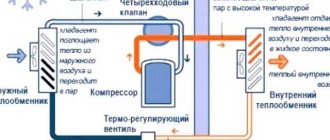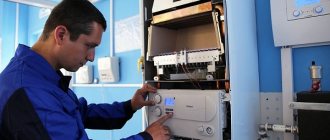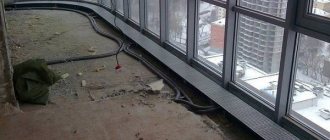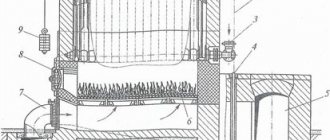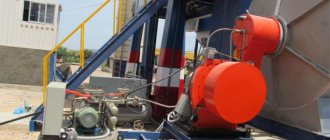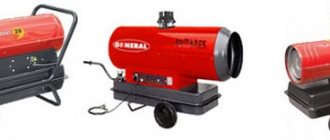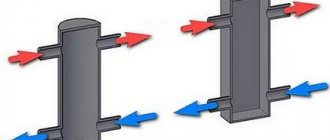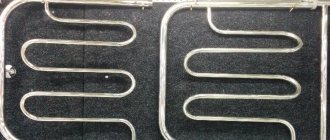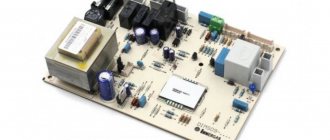At any time of the year, fan coil units are capable of maintaining a comfortable air temperature in the room; many people do not know what it is. They are internal blocks of a centralized cooling and heating system. The air conditioner was replaced by a fan coil climate control unit, the name of which comes from the English language: fan is a fan, and coil is a heat exchanger. This unit maintains optimal temperature inside the room in winter and summer. The movement of air flows is carried out due to the presence of a fan.
During consultation, the designer explains to the customer what a fan coil is. As a result, such an air conditioning and heating system for a group of office rooms or for a private house with a large number of rooms is chosen as the best option.
What is a fan coil
The configuration of private houses and public buildings in the plan is divided into areas with different temperature conditions. Each room should be served by a fan coil that automatically turns on, cooling or heating the space to the desired temperature. This is a device that ensures the heat exchange process inside each room in buildings of medium and large area.
To minimize risks and purchase a device with a long service life, the selection of a fan coil unit must be made based on calculation. This energy-saving engineering equipment must comply with current GOST and SNiP standards. For efficient operation of the fan coil unit, it is necessary to correctly assemble the piping unit. In the process of designing the system, it is necessary to take into account the specifics of the rooms, their parameters, the type and thickness of the external walls, and the sizes of window openings.
Fan coil design
Fan coil unit is an internal unit consisting of: a fan, a heat exchanger, an air purification filter and a control panel. Thanks to the fan coil heat exchanger, the air is cooled or heated, depending on the time of year. Hot or cold water is supplied to the fan coil units through a pipeline system. The source of cold water with the required parameters (7-12°C) is a chiller. The source of warm water can be a boiler or an existing heating system. Coolant circulation is ensured by a hydraulic module or pumping station, consisting of circulation pumps, expansion tanks and safety groups.
Operating principle of fan coil
Climate control devices provide air circulation and maintain the set temperature. They are not stand-alone equipment, they are part of a customized system. The fan coil operates using a fan and a heat exchanger that are built into it. Replaces water heating during frosty periods and air conditioning in summer, all year round, without deviating from the set comfortable temperature in all rooms.
The principle of operation of a fan coil unit is similar to the operation of an air conditioner in a split system, but the key difference is that water or antifreeze is used as the coolant, and not freon, which is unable to work at sub-zero temperatures outside the window. Thanks to the liquid circulating through the pipes, which serves as heat or coolant, the fan coil is used all year round, providing centralized heating and air conditioning for the entire building.
The source of cold in the system is a chiller, a refrigeration machine installed on the roof or in a technical room, which does not require complex seasonal maintenance. With high power pumping equipment, the fan coil unit can be installed at an unlimited distance from the chiller in the building. In winter, the automation switches the network to heating the coolant through a heating boiler.
Chiller-fan coil system diagram
It is not difficult to understand how a fan coil unit works. The coolant moves through a two-pipe system when cooling rooms. If it is necessary to heat one room and cool another, a multi-zone system is installed with the division of cold and hot water into different branches. A fan coil unit with double-circuit heat exchangers is used; it is connected via a four-pipe circuit to sources of heat and cold simultaneously.
The number of fan coil units in one room is determined by calculation and depends on the size of the premises served, their height, parameters of openings and external walls, maximum summer and winter temperatures in the region, and wind speed. All heat losses in structures are taken into account.
The fan coil device consists of two fundamental parts - a radiator and a fan, controlled by its own controller based on a sensor signal. The heat exchanger of a fan coil unit circulates water supplied through a network of pipes from the chiller or boiler, and the fan moves the air flow from large spaces in offices to the radiator for heating or cooling.
Application
These units are used to cool and heat air to the desired temperature. Using the devices, you can control the microclimate in rooms for various purposes. Installation of a duct-type fan coil can be done both in a spacious and in a relatively small room. Such equipment is in demand at industrial and residential facilities, including:
- Exhibition pavilions;
- Office and administrative buildings;
- Restaurants, cafes, bars;
- Shops and shopping centers.
It is duct, and not cassette fan coils, that are recommended by experts for air-conditioning rooms with an open space layout. It is very functional and is often used in offices, banks and other commercial buildings. As a rule, we are talking about objects with a large area, for zoning of which low partitions are used. The air conditioning of this room has its own characteristics, since the division into zones is only at the bottom, and closer to the ceiling the space is single.
Partitions between workstations create a certain obstacle to air circulation. If conditioned air is supplied from several points, it is more evenly distributed throughout the room.
As for residential facilities, this technology can be used to control the temperature in houses, cottages, and apartments. Since the device looks almost invisible, it does not disturb the harmony of the space. Manufacturers offer different types of decorative grilles for fan coil units, so you can choose an option to suit any design.
Pros and cons of using a fan coil
The units have many advantages that ensure their widespread use indoors:
- Provide better air circulation compared to heating radiators.
- Fan coil allows you to reduce the temperature of the coolant.
- The system makes it possible to produce vestibule heating of exits from buildings with a large flow of people.
- In the distribution of communications of such systems, thermally insulated water pipes are used. You need to choose a fan coil based on the thermal power to centrally maintain the set temperature.
- By placing bulky chillers outside or in the attic, usable space is saved.
- Fan coil provides free temperature control in a large number of rooms.
- Minimal risks of emergency situations.
- Environmental safety due to the absence of freon as a refrigerant.
HVAC company professionals will advise you on which fan coil to purchase and how to choose. Parameters such as power, dimensions, performance, connection diagrams, and air stream length are of great importance. During the consultation process, engineers will show photos of units from various manufacturers.
The fan coil unit has one drawback - sometimes there is a slight noise when the fan built into the device operates. Engineers and technical workers who install climate control equipment recommend purchasing models with enhanced sound insulation. Before operation, it is necessary to correctly configure the device for heating and cooling air.
Fan coil connection diagram
Having learned what a fan coil is and how it works, you need to study the installation diagram. It depends on the selected model and climate control system. The location of the module must ensure effective cooling (heating) of the air in the room. There are no obstacles in the path of air flows - furniture, interior items. There must be easy access for maintenance and repair.
Installation is done according to the general scheme.
- Installing the housing in the selected location.
- Pipeline connection.
- Installation of piping - valves, taps, temperature sensors.
- Condensate drainage. For this, a pump and a separate pipeline are used. Pump characteristics - performance and maximum lift height.
- Electrical connection.
- Pressure testing and leak testing.
After this, the system is filled with working fluid. The instructions for a specific model describe how to connect the fan coil to the chiller. Dimensions, power requirements, and temperature conditions are taken into account.
Important. To minimize changes in the temperature of the working fluid, the pipes must be insulated. Thermal insulation materials – polyurethane foam, polyethylene foam, mineral wool.
Types of fan coil units
Depending on the installation method, there are 3 types of units:
- wall;
- cassette;
- duct.
The wall-mounted water fan coil unit has compact dimensions, is selected according to the parameters and purpose of the room, is mounted openly on a supporting structure, and is fixed at a short distance from the ceiling. Installation is simple, easy fastening system, inexpensive. The fan coil has an attractive appearance. Manufacturers make the body from plastic for full style modeling in interior design.
Industrial high-pressure wall-mounted fan coils are often found in manufacturing plants. The tangential fan provides low noise levels and high air flow power.
The cassette unit is built into a suspended ceiling; these types of fan coil units, which meet all regulations and standards, are used in large areas - in offices, hotels, cafes, restaurants, administrative institutions. The cassette fan coil is a frameless unit and is designed for hidden installation; it is placed behind the ceiling tiles, only the front decorative panel with adjustable blinds distributing air flows is visible.
Duct fan coil is designed for ventilation of large spaces. The horizontal type device is installed in the supply ventilation duct behind the suspended ceiling, the vertical type - behind false walls. Supply both fresh and purified recirculated air. Water pipes are connected to it via threaded connections. The fan coil unit is equipped with a powerful centrifugal fan capable of overcoming network resistance. When selecting such units, you need to pay attention to the maximum permissible length of the line.
Fan coil elements
Fan coil heat exchanger
The fan coil heat exchanger is made of copper tubes with aluminum fins attached to them, through which cold or hot water is supplied.
On one side of the heat exchanger there are pipes for connecting to pipelines and air valves for releasing air when the system is filled with water. The heat exchanger usually has two or three rows of tubes. In the photo: Fan coil heat exchanger
Fan coil air filter
This is an easily removable, washable mesh or soft filter element.
Depending on the type of fan coil unit, additional air filters may be installed in it for better air purification. They can be carbon, catechin or with silver ions - to clean the air from foreign odors, germs, viruses. In the photo: Air filters for fan coil units
These filters are purchased separately. They are small in size, but thanks to recirculation, when the air passes through these filters multiple times, the air is almost completely purified of harmful impurities and disinfected.
Fan coil motor
Small and medium-sized fan coil units usually use multi-speed motors with switchable speed or voltage control, which allows for stepwise or smooth changes in the speed of the fan coil fan.
In the photo: Fan coil electric motor
Typically, fan coil units use a centrifugal type fan. It distributes the flow evenly along the entire length of the fan coil and makes little noise. In fan coil units of low and medium power, up to approximately 20 kW, direct drive motors are installed. On fan coil units of higher power, fans with V-belt drive are used.
Drainage pump
During operation of the fan coil unit, warm air from the room passes through it, and when cooled, moisture is formed.
If this water accumulates, ideal conditions are created in the pan for the development of bacterial and fungal infections, and an unpleasant odor appears. Proper organization of condensate drainage is one of the most important conditions when installing climate control equipment.
The fan coil unit must be equipped with a reliable condensate drainage system, and the drainage tube must be regularly cleaned - blown with air and rinsed with water and household grease solvent, since during operation, especially constant and long-term use, the tube becomes heavily clogged.
In the photo: Fan coil drainage system
The condensate drain from the fan coil can be vented outside, with a rigid or flexible pipe for draining the fan coil condensate attached to the outer wall of the building.
Condensation from the air conditioner can be discharged into the sewer.
It must be taken into account that condensate drainage from the fan coil unit into the sewer by gravity is possible only with a minimum angle of inclination of the drainage pipe of 3 degrees, or better - 5 degrees. If this angle is smaller, a special pump is needed - a drainage pump, with the help of which condensate is forced to drain under pressure.
Tray for collecting condensate in fan coil units
The condensate collection tray in fan coil units ensures the collection and removal of condensate that forms on the surface of the cooling heat exchanger when the fan coil is installed vertically or horizontally.
Sometimes an additional tray is provided to collect condensate formed at the connection points of three-way or balancing valves when they are installed as part of a fan coil unit. The tray is placed in the frame and fixed with special guides on the fan coil body. In the photo: Tray for collecting condensate in fan coil units
Three-way valves for fan coil units
Three-way valves can be installed separately in the line or built directly into the fan coil body. Depending on the way the fan coil units are controlled, the three-way valve either redirects the water supply, bypassing the fan coil unit, or regulates the water flow through the fan coil unit, depending on the temperature conditions in the room.
In the photo: Three-way valves for fan coil units
Installing a three-way valve improves the performance of the system, but significantly increases its cost, so the use of a three-way valve must be justified.
Manufacturers
There are a large number of fan coil manufacturers on the air conditioning equipment market, whose products have been tested in operation and deserve the trust of Russian consumers. This is the world famous Japanese brand Daikin - an innovator in the field of science-intensive and high-tech developments, the American brand Yor, Venterra from Italy. And also: IGC, Trane, Aermec, Carrier, Royal Clima, Electrolux, Ballu, Climaveneta, Aeronik, Wesper, General Climate, Rhoss, MDV and many others.
Qualified engineers who have experience working with climate control equipment and know its features should select and install a fan coil unit.
How does a chiller-fan coil system work?
We have already learned a lot about fan coils: what they are, the principle of their operation, and compared heat closers with air conditioners. It's time to get acquainted with chillers - devices without which the entire thermoregulatory functionality of fan coil units would lose all meaning. Let's look at how one of the most promising types of chillers interact with thermal closers.
Operation of an absorption refrigeration machine
An absorption chiller (ABCH) uses a special absorber - a binary aqueous solution of lithium bromide. The operation of a refrigeration machine is based on the property of the refrigerant to actively absorb heat during the transition phase of vapor into a liquid state of aggregation. Chillers of this design are capable of absorbing thermal energy from any other industrial equipment. The absorbent absorbent is highly soluble in water, having a much higher boiling point. The cyclic operation of a chiller of this class occurs in the following sequence:
- Heat from an external source is supplied to the generator, where the lithium bromide solution is heated. As the solution boils, water evaporates;
- The steam is sent to the condenser, where it precipitates, turning into a liquid state;
- The refrigerant (water) passes into the throttle, cools in it, and as a result its pressure decreases;
- The liquid fills the solvent, and the water evaporates and the vapor is absorbed by lithium bromide. During absorption, the room air is cooled;
- The diluted absorbent is once again heated in the generator and the cycle repeats.
Fan coil coil
The fan coil piping assembly diagram includes:
- shut-off ball valve
- strainer
- three-way or two-way valve with electric drive
- drainage pipe
- balancing valve
- air release valve
A three-way valve is installed if the refrigeration system has a constant liquid flow. Two-way valves are used in variable flow systems. Shut-off valves are installed on the return and liquid supply for ease of maintenance of the fan coil unit. To prevent contamination of the heat exchanger, it is recommended to install a strainer. The air valve is necessary to bleed air from the system. When repairing the fan coil heat exchanger, it is necessary to drain the liquid from it; a drainage pipe is provided for this.
Varieties
The devices that make up the chiller-fan coil system can operate either independently or in a single complex. The types and varieties of the system depend on which chiller or fan coil unit is installed. Therefore, we will consider their types separately.
The chiller can be:
- Reversible . That is, a device that can both heat and cool the coolant.
- Vapor compression. In this unit, the refrigerant circulates inside the unit and removes heat to a special chamber.
- Absorption. This device uses high pressure. As a result, the vapor or liquid changes its state, releasing heat or removing it. With the help of an absorbent, for example, heat is transferred to the consumer.
- Air cooled.
- With remote cooling circuit.
Fan coil units:
- Cassette.
- Duct.
They can be installed on the ceiling, walls, or floor.
How to make a dehumidifier with your own hands, step-by-step instructions. Read which humidifier is good for a child.
Read how to choose a vacuum pump for air conditioners at https://klimatlab.com/ventilyaciya/kondicionirovanie/vakuumnyj-nasos-dlya-kondicionerov.html
Options
The device is selected according to the following parameters:
- Chiller power.
- Fan coil performance.
- Movement of air masses.
- Power of the pumping station, pipeline lengths, thermal insulation of pipes.

